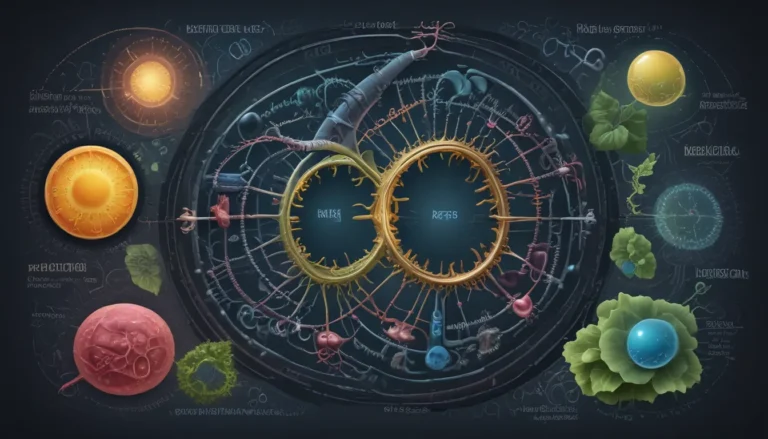A Note About Images: The images used in our articles are for illustration purposes only and may not exactly match the content. They are meant to engage readers, but the text should be relied upon for accurate information.
Cell signaling is a complex and essential process that allows cells to communicate and respond to external signals, influencing a wide range of physiological functions. From embryonic development to immune response, signal transduction pathways play a crucial role in regulating cellular processes. In this article, we will take a deep dive into 11 extraordinary facts about signal transduction pathways to explore how cells interpret and respond to their environment.
The Significance of Signal Transduction Pathways
Signal transduction pathways act as messengers within cells, facilitating communication and response to external cues. These pathways are integral to various physiological functions and can be targeted by drugs for therapeutic purposes. Protein phosphorylation and second messengers are key components of signal transduction, influencing gene expression and cellular processes. Dysregulation of these pathways can lead to the development of diseases.
Understanding Cellular Communication
Signal transduction pathways are crucial for cellular communication, allowing signals from the external environment to be transmitted to the cell’s nucleus. This process enables cells to respond to different stimuli and adapt to changing conditions. By unraveling the complexities of these pathways, researchers can gain valuable insights into how cells function and how diseases may arise.
Exploring the Diversity of Signal Transduction Pathways
There are multiple types of signal transduction pathways, each serving unique roles within the cell. G protein-coupled receptors (GPCRs), receptor tyrosine kinase (RTK) pathways, and intracellular signaling pathways are just a few examples of the diverse mechanisms through which cells interpret and respond to signals from their environment.
The Role of Protein Phosphorylation
Protein phosphorylation is a critical event in signal transduction, involving the addition of a phosphate group to a protein. This modification is essential for relaying signals within the cell and is a key mechanism by which cellular processes are regulated. By understanding the intricacies of protein phosphorylation, researchers can uncover the underlying mechanisms of various diseases.
Impact on Gene Expression
Signal transduction pathways often lead to changes in gene expression, influencing the cellular processes that drive development, growth, and disease progression. By modulating gene expression, these pathways play a key role in shaping the behavior of cells and their response to external stimuli.
Interactions Between Pathways
Crosstalk between signal transduction pathways is a common occurrence, allowing for intricate communication and regulation within the cell. By understanding how different pathways interact, researchers can gain insights into the complex networks that govern cellular behavior and function.
Link to Disease
Abnormalities in signal transduction pathways have been implicated in various diseases, including cancer, neurological disorders, and autoimmune conditions. Dysregulation of these pathways can disrupt normal cellular processes, leading to the development and progression of disease.
The Role of Second Messengers
Second messengers, such as cyclic AMP (cAMP) and calcium ions, serve as intermediaries in signal transduction pathways, amplifying and propagating signals within the cell. These molecules play a vital role in transmitting signals and coordinating cellular responses to external stimuli.
Ligand-Receptor Interactions
The activation of signal transduction pathways often begins with specific ligand-receptor interactions, where binding of ligands to cell surface receptors triggers a cascade of events that culminate in cellular responses. Understanding these interactions is essential for deciphering how cells interpret external signals.
Feedback Regulation
Signal transduction pathways can exhibit feedback regulation, allowing for precise control and adjustment of cellular responses to changing environmental conditions. Feedback loops play a crucial role in maintaining cellular homeostasis and ensuring proper signaling within the cell.
Involvement in Developmental Processes
Signal transduction pathways are essential for embryogenesis, tissue differentiation, and organ development, ensuring proper growth and morphogenesis. These pathways play critical roles in shaping the architecture and function of tissues and organs during development.
Therapeutic Potential
Pharmaceutical agents can be designed to target specific components of signal transduction pathways, making them potential therapeutic interventions for various diseases. By modulating the activity of these pathways, researchers can develop targeted therapies that address the underlying mechanisms of diseases.
In conclusion, signal transduction pathways are fundamental to cellular communication and regulation, influencing a wide range of physiological functions. By unraveling the intricate mechanisms and components of these pathways, researchers can gain valuable insights into the inner workings of cells and the development of diseases. From the role of second messengers to the importance of feedback loops, signal transduction pathways provide a rich area of study for biologists and medical researchers.
FAQs
-
What is a signal transduction pathway?
A signal transduction pathway is a series of molecular events that allows cells to receive, process, and respond to extracellular signals, such as hormones or growth factors. -
What are some common components of signal transduction pathways?
Common components include receptors, second messengers like cyclic AMP, and protein kinases that modify proteins by adding phosphate groups. -
How do signal transduction pathways regulate cellular processes?
They regulate cellular processes by activating or inhibiting specific genes, enzymes, or proteins, leading to changes in cell proliferation, differentiation, or metabolism. -
Are signal transduction pathways involved in diseases?
Yes, dysregulation of these pathways can contribute to the development of diseases like cancer, diabetes, and neurodegenerative disorders. -
How can studying signal transduction pathways benefit medical research?
Studying these pathways can provide insights into disease mechanisms, leading to the development of targeted therapies that modulate pathway activity for more effective treatments.
Signal transduction pathways are a captivating field of study, offering a glimpse into the intricate world of cellular communication. By exploring these pathways and uncovering their secrets, researchers can expand our understanding of fundamental biological processes and pave the way for innovative medical treatments. Join us on this journey through the fascinating landscape of cellular signaling and discover the wonders that await.






